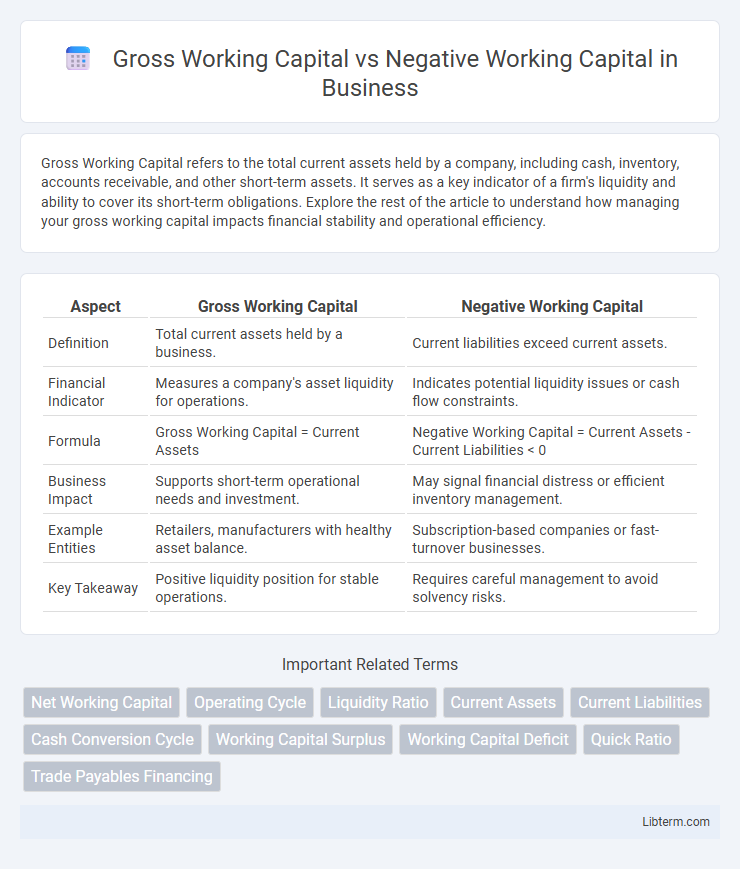Gross Working Capital refers to the total current assets held by a company, including cash, inventory, accounts receivable, and other short-term assets. It serves as a key indicator of a firm's liquidity and ability to cover its short-term obligations. Explore the rest of the article to understand how managing your gross working capital impacts financial stability and operational efficiency.
Table of Comparison
| Aspect | Gross Working Capital | Negative Working Capital |
|---|---|---|
| Definition | Total current assets held by a business. | Current liabilities exceed current assets. |
| Financial Indicator | Measures a company's asset liquidity for operations. | Indicates potential liquidity issues or cash flow constraints. |
| Formula | Gross Working Capital = Current Assets | Negative Working Capital = Current Assets - Current Liabilities < 0 |
| Business Impact | Supports short-term operational needs and investment. | May signal financial distress or efficient inventory management. |
| Example Entities | Retailers, manufacturers with healthy asset balance. | Subscription-based companies or fast-turnover businesses. |
| Key Takeaway | Positive liquidity position for stable operations. | Requires careful management to avoid solvency risks. |
Understanding Gross Working Capital
Gross Working Capital refers to a company's total current assets, including cash, accounts receivable, inventory, and marketable securities, essential for daily operational liquidity. It provides a clear picture of the firm's short-term asset base without accounting for current liabilities, highlighting the available resources for business activities. Understanding Gross Working Capital is crucial for managing liquidity, optimizing cash flow, and making informed decisions about financing and investment strategies.
What is Negative Working Capital?
Negative working capital occurs when a company's current liabilities exceed its current assets, indicating potential liquidity issues. Unlike gross working capital, which represents the total current assets available to fund day-to-day operations, negative working capital suggests the firm might struggle to cover short-term obligations without additional financing. This situation can arise in businesses with fast inventory turnover or strong cash flow but may signal financial distress in other cases.
Key Differences Between Gross and Negative Working Capital
Gross working capital refers to a company's total current assets, including cash, inventory, and receivables, which indicate available resources for operations. Negative working capital occurs when current liabilities exceed current assets, signaling potential liquidity issues and challenges in meeting short-term obligations. Key differences include the liquidity position where gross working capital reflects asset availability, while negative working capital highlights financial strain and possible operational risks.
Components of Gross Working Capital
Gross Working Capital comprises a company's total current assets, including cash, accounts receivable, inventory, marketable securities, and prepaid expenses, which are essential for daily operations and short-term financial health. Negative Working Capital occurs when current liabilities exceed current assets, indicating potential liquidity issues or efficient management of short-term obligations. Understanding the components of Gross Working Capital helps in analyzing liquidity, operational efficiency, and the company's ability to meet short-term commitments.
Causes of Negative Working Capital
Negative working capital occurs when a company's current liabilities exceed its current assets, signaling potential liquidity issues. Common causes include prolonged payment terms to suppliers, rapid inventory turnover, or aggressive expansion without sufficient short-term asset buildup. Companies with strong cash flow can sustain negative working capital as a strategic choice, but it often indicates financial stress in less stable businesses.
Impact on Business Operations
Gross working capital represents the total current assets available to support day-to-day business operations, directly impacting liquidity and operational efficiency. Negative working capital occurs when current liabilities exceed current assets, signaling potential cash flow problems and difficulty in meeting short-term obligations. This imbalance can disrupt inventory management, vendor payments, and overall financial stability, risking business continuity and growth.
Financial Health Indicators
Gross working capital represents a company's total current assets, indicating liquidity and operational efficiency, while negative working capital occurs when current liabilities exceed current assets, signaling potential cash flow issues. Positive gross working capital reflects a strong short-term financial position, essential for meeting obligations and funding daily operations, whereas negative working capital may highlight financial stress or a need for immediate corrective measures. Analyzing these indicators helps stakeholders assess a company's ability to sustain operations, manage debts, and maintain overall financial health.
Managing Gross Working Capital Effectively
Efficient management of Gross Working Capital involves maintaining an optimal balance between current assets and liabilities to ensure liquidity and operational stability. Firms focus on inventory turnover, accounts receivable collection, and cash reserves to maximize working capital efficiency and support day-to-day expenses. Negative Working Capital often indicates cash flow problems, prompting businesses to improve receivables management and shorten payment cycles to avoid solvency risks.
Risks and Benefits of Negative Working Capital
Negative working capital indicates a company's current liabilities exceed its current assets, often signaling liquidity risks such as difficulty meeting short-term obligations. However, businesses with negative working capital may benefit from efficient cash flow management, faster inventory turnover, and strong supplier credit terms that reduce the need for large cash reserves. The key risk lies in potential insolvency during economic downturns, while the benefit is improved operational efficiency and potential capital redeployment for growth initiatives.
Choosing the Right Capital Management Strategy
Gross working capital represents a company's total current assets used to fund day-to-day operations, while negative working capital occurs when current liabilities exceed current assets, indicating potential liquidity issues. Choosing the right capital management strategy involves assessing the business model's cash flow dynamics and industry standards to determine whether maintaining positive gross working capital or leveraging negative working capital enhances operational efficiency. Effective management balances liquidity needs with profitability targets, optimizing asset utilization and minimizing financing costs.
Gross Working Capital Infographic

 libterm.com
libterm.com